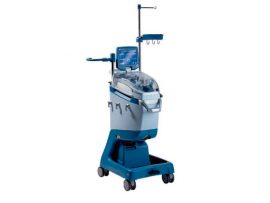Abstract Background The global prevalence of congenital heart disease (CHD) is increasing. Research on patient-reported outcomes (PROs) predominantly originates from high-income countries, resulting in an incomplete understanding of the true global..
Read MoreAbstract Objetives Extracorporeal membrane oxygenation (ECMO) after surgery for congenital heart disease (CHD) provides hemodynamic support to patients when their myocardial function is temporarily affected. Postoperative infections in children with..
Read MoreAbstract Introduction Amino acids (AAs) serve diverse roles, and insufficient delivery is associated with worse outcomes in ill patients. In the case of congenital heart disease (CHD) surgery with cardiopulmonary..
Read MoreAbstract OBJECTIVES Current preoperative counselling in neonatal cardiac surgery is mainly focused on the primary procedure. However, other factors must be considered when evaluating the surgical risk of a neonate...
Read MoreAbstract OBJECTIVES Acute kidney injury commonly complicates congenital heart surgery with cardiopulmonary bypass, increasing morbidity and mortality. This study aimed to evaluate risk factors for postoperative acute kidney injury and..
Read MoreAbstract Background Survival for hypoplastic left heart syndrome (HLHS) and variants has improved over the past 4 decades; however, survival remains low compared with other forms of congenital heart disease...
Read MoreAbstract Introduction Congenital cardiac defects disrupt circulation and oxygenation due to structural changes in the heart. Tetralogy of Fallot is the most common cyanotic congenital heart disease, accounting for 5..
Read MoreAbstract Background Acute kidney injury (AKI) is common in children with congenital heart disease following open-heart surgery with cardiopulmonary bypass (CPB). Early AKI detection in critically ill children requires clinician..
Read MoreAbstract This study aimed to describe patient characteristics, mortality, and morbidity outcomes in children at a South African extracorporeal membrane oxygenation (ECMO) center. Fifty-seven patients required ECMO from 2018 to..
Read MoreAbstract Background and Aims Innovative advancements in cardiopulmonary bypass (CPB) configurations, such as surface coating, blood filtration, and miniaturization, aim to reduce gaseous microemboli (GME) that contribute to embolic organ..
Read MoreAbstract Background We undertook this study to evaluate the efficacy of an on-table extubation protocol and to assess the magnitude of benefits when implemented as a routine practice in a..
Read MoreAbstract Objectives To describe longer-term survival and morbidity outcomes after hospital discharge in a binational cohort of children who required extracorporeal membrane oxygenation after cardiac surgery. Methods This was a..
Read MoreAbstract Objective To assess the effects of dexmedetomidine (DEX) on cerebrovascular autoregulation in children with congenital heart disease (CHD) using transcranial color-coded duplex sonography (TCCD). Design Randomized controlled trial. Setting..
Read MoreAbstract Background The human bioaccumulation of micro- and nano-plastics (MNPs) is increasingly being recognised in the aetiology and pathophysiology of human disease. Objective This systematic scoping review aims to provide..
Read MoreAbstract Abstract Objective To investigate cerebral autoregulation impairment during neonatal cardiac surgery. Design A retrospective observational study. Setting Single-center, university teaching children’s hospital. Participants Neonates undergoing surgery for critical congenital..
Read MoreIntroduction Superlatives and acronyms abound in this year’s edition of annual noteworthy literature for Seminars in Cardiothoracic and Vascular Anesthesia. By the numbers, over 22 000 publications from 2024 were screened, and approximately..
Read MoreAbstract Background: Plastic-containing medical devices are commonly used in critical care units and other patient care settings. Patients are often exposed to xenobiotic agents that are leached out from plastic-containing..
Read MoreAbstract Background Current indicators for monitoring intraoperative organ function remain predominantly indirect, delayed and non-specific, particularly in paediatric populations undergoing congenital heart surgery, where multifactorial influences further complicate functional assessments. Emerging..
Read MoreAbstract Evaluating the impact of cardiac surgery on humoral and cellular immunity in pediatric congenital heart disease patients with prior Severe Acute Respiratory Syndrome Coronavirus 2 (SARS-CoV-2) infection or vaccination..
Read MoreAbstract BACKGROUND Exposure to supra-physiologic levels of oxygen has been associated with end-organ damage and worse outcomes across multiple populations related to oxidative stress and inflammation. There is limited evidence..
Read MoreAbstract The use of extracorporeal membrane oxygenation (ECMO) in the paediatric population has increased over time, with the ability to rescue pulmonary and cardiovascular deterioration. ECMO can be utilised by..
Read MoreAbstract Background Minimally invasive thoracotomies to repair selected congenital heart defects are considered only a cosmetic alternative approach by many; however, they represent the routine alternative in centers of expertise...
Read MoreAbstract Background Some unrestrictive congenital shunts put patients at high risk for developing irreversible pulmonary vascular disease if not closed in the first year of life. Living at high altitude..
Read MoreAbstract Introduction Sternotomy has been the most common approach for the correction of congenital cardiac defects, and questions arise surrounding the safety, feasibility, and cost-effectiveness of implementing minimally invasive techniques..
Read MoreAbstract Background Congenital heart disease is the most common neonatal congenital condition. Surgery is often necessary. Patients with congenital heart disease are potentially exposed to red cell transfusion preoperatively, intraoperatively..
Read MoreAbstract Background We evaluated outcomes of neonatal cardiac surgery at hospitals affiliated with the European Congenital Heart Surgeons Association (ECHSA). Methods All patients ≤30 days of life undergoing a cardiac..
Read MoreAbstract Background The objective of this study was to evaluate mean cerebral blood flow velocity, gaseous microemboli (GME) counts, regional cerebral oxygen saturation (rSO2), and clinical outcomes using multimodality neuromonitoring..
Read MoreAbstract A circular shunt, initially described by Shone et al. in 1962, refers to abnormal blood recirculation through complete intracardiac or intra- and extracardiac communications, bypassing the capillary beds. This..
Read MoreAbstract Over 10% of children develop thrombosis after cardiac surgery for congenital heart disease. Children with a single ventricle physiology have the highest risk of thrombosis associated with increased length..
Read MoreAbstract Background Hospital-acquired infections (HAIs) are associated with morbidity and mortality in children following congenital cardiac surgery. Our center performs approximately 200 congenital surgeries a year, but infection rates and..
Read More
















